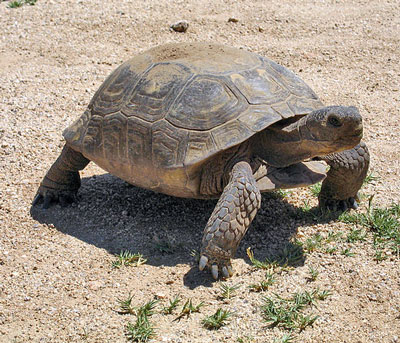Desert Tortoise
Scientific Classification
| Kingdom: | Animalia |
| Phylum: | Chordata |
| Class: | Sauropsida |
| Order: | Testudines |
| Suborder: | Cryptodira |
| Superamily: | Testudinoidea |
| Family: | Testudinidae |
| Genus: | Gopherus |
| Species: | G. agassizii |
| Binomial name: | Gopherus agassizii |
The history of desert tortoises dates back several million years ago. During this long period, they had to adapt to lots of changes in climatic and geological terms, which happened in the southern parts of California. Desert Tortoises live in diverse desert habitats. Of course, they require friable or crumbly soil to make burrows as well as nests. These tortoises are very common in the desert regions where you see creosote in abundance. You can rarely see them on the steep slopes of desert areas. Tortoises are at their active best between the months of March to June. When the temperature becomes too warm in late summer, they seldom move out of their burrows. These tortoises are highly sensitive to heat. Extreme desert heat can account for their death in a little less than an hour. Desert Tortoises hibernate during winter.

Anatomy

Desert tortoises Gopherusagassizii and Gopherus morafkai may reach lengths of Ten to Fourteen inches (twenty-five to thirty-six centimeters). The males are a little larger than the females of the species. Male desert tortoises possess longer, gular horns when compared to the females. The plastrons or lower shells of the males are concave in comparison with the females. Males also possess larger tails than the females. They have high-domed shells which are colored either greenish tan or dark brown. These desert tortoises can reach heights of 4 to 6 inches or 10 to 15 centimeters. Their weights can range from 11 to 23 Kilos or between 24 and 51 pounds. The sharp, claw-like scales on the front limbs are flat to aid digging. The back legs are rather skinny and very long.
Behavior
Desert tortoises show some interesting patterns in their social behavior. When two tortoises meet, they bob their heads at each other quite formally. Funnily, they do the same in combat or when establishing territory and for better effect, they add a lot of hissing and vocal sounds.
Habitat
Scientifically, desert tortoises are divided into two: The Morafka’s and the Agassiz’s. There is possibly a third desert type in southern Sonora and northern Sinaloan, in Mexico. You can spot an isolated Agassiz’s population of the desert tortoise in Northwest Arizona’s Black Mountains.
As a Pet
Breeding
The breeding of the desert tortoise is from April to July, a short time after they come out from hibernation. The Females lay 1-3 clutches of eggs. Each clutch has around five eggs. In three or four months, the eggs hatch.
Housing

The desert tortoise, as a pet, needs a secure environment. The habitat should have one enclosure and a shelter with an area of about 18’ x 18’ or Three Hundred and Twenty four Sq. feet. This should include a grassy patch of about 6’ x 6’. You should also provide for native vegetation like herbs, vines and mallows along with the grass. All this together will comprise an excellent staple diet for these tortoises.
If your dog expresses any interest in your tortoise, you should make a high enough enclosure fence to dissuade the dog. Even if you own other tortoises or turtles as pets, your desert tortoise should have an exclusive enclosure. You should also take care to fence off your pools, spas or fish ponds. Desert tortoises are not swimmers and they will drown if they happen to fall into a deep or not so deep water.
You must provide for the tortoises to regain dry ground, sun, water or shade. If your backyard is fenced, your tortoise can use the entire area as an enclosure. In case your backyard doesn’t have a fence, you very well can stack cinder blocks 18” high to make an enclosure and if is made from hardware cloth or such stuff, make sure to provide a lip on the top edges to see that the tortoise does not climb the wall and amble off.
Food
Desert tortoises are totally herbivorous. This means that they are strict vegetarians. In their wild state, they could happily browse on a wide variety of plants. In captivity, the best diet is the one that will provide the variety of foods that will meet the tortoise’s nutritional needs. The ideal thing would be to provide grass, leafy vegetables and plants as well as flowers that the tortoise can consume. Since grass comprises a significant part of your pet’s healthy diet, you can set up a grass patch, large enough for your tortoise to graze on. Apart from grass, you can plant filaree, dichondra (of the family of Morning Glory), hibiscus, dandelions, mulberry, wild grape and wildflowers like globe mallow. Your pet can feast on the various parts of the plant to its heart’s content.
You can give fruits to your pet as a treat. You must ensure that water is available in the enclosure all the time. You should always keep the water dish in the same place, so that your pet will know where to look for water.
Handling
You would do well to refrain from keeping these tortoises as pets if you favor petting. A pet should not mean an animal that is frequently handled. Tortoises fare best with minimal handling’ You can get a lot of pleasure by closely watching the pet’s natural behavior.

Having discovered a fondness for insects while pursuing her degree in Biology, Randi Jones was quite bugged to know that people usually dismissed these little creatures as “creepy-crawlies”.







